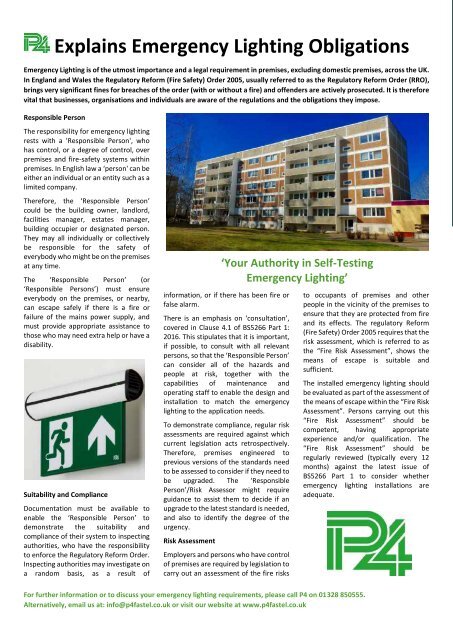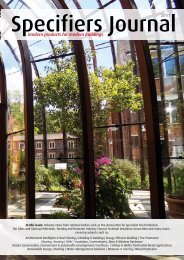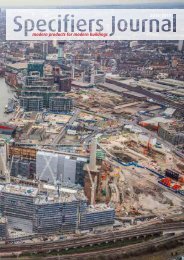ECOBuilder-Specifiers Journal spring2018
Create successful ePaper yourself
Turn your PDF publications into a flip-book with our unique Google optimized e-Paper software.
Explains Emergency Lighting Obligations<br />
Emergency Lighting is of the utmost importance and a legal requirement in premises, excluding domestic premises, across the UK.<br />
In England and Wales the Regulatory Reform (Fire Safety) Order 2005, usually referred to as the Regulatory Reform Order (RRO),<br />
brings very significant fines for breaches of the order (with or without a fire) and offenders are actively prosecuted. It is therefore<br />
vital that businesses, organisations and individuals are aware of the regulations and the obligations they impose.<br />
Responsible Person<br />
The responsibility for emergency lighting<br />
rests with a 'Responsible Person', who<br />
has control, or a degree of control, over<br />
premises and fire-safety systems within<br />
premises. In English law a ‘person' can be<br />
either an individual or an entity such as a<br />
limited company.<br />
Therefore, the ‘Responsible Person’<br />
could be the building owner, landlord,<br />
facilities manager, estates manager,<br />
building occupier or designated person.<br />
They may all individually or collectively<br />
be responsible for the safety of<br />
everybody who might be on the premises<br />
at any time.<br />
The ‘Responsible Person’ (or<br />
‘Responsible Persons’) must ensure<br />
everybody on the premises, or nearby,<br />
can escape safely if there is a fire or<br />
failure of the mains power supply, and<br />
must provide appropriate assistance to<br />
those who may need extra help or have a<br />
disability.<br />
Suitability and Compliance<br />
Documentation must be available to<br />
enable the ‘Responsible Person’ to<br />
demonstrate the suitability and<br />
compliance of their system to inspecting<br />
authorities, who have the responsibility<br />
to enforce the Regulatory Reform Order.<br />
Inspecting authorities may investigate on<br />
a random basis, as a result of<br />
information, or if there has been fire or<br />
false alarm.<br />
There is an emphasis on ‘consultation’,<br />
covered in Clause 4.1 of BS5266 Part 1:<br />
2016. This stipulates that it is important,<br />
if possible, to consult with all relevant<br />
persons, so that the ‘Responsible Person’<br />
can consider all of the hazards and<br />
people at risk, together with the<br />
capabilities of maintenance and<br />
operating staff to enable the design and<br />
installation to match the emergency<br />
lighting to the application needs.<br />
To demonstrate compliance, regular risk<br />
assessments are required against which<br />
current legislation acts retrospectively.<br />
Therefore, premises engineered to<br />
previous versions of the standards need<br />
to be assessed to consider if they need to<br />
be upgraded. The ‘Responsible<br />
Person’/Risk Assessor might require<br />
guidance to assist them to decide if an<br />
upgrade to the latest standard is needed,<br />
and also to identify the degree of the<br />
urgency.<br />
Risk Assessment<br />
‘Your Authority in Self-Testing<br />
Emergency Lighting’<br />
Employers and persons who have control<br />
of premises are required by legislation to<br />
carry out an assessment of the fire risks<br />
to occupants of premises and other<br />
people in the vicinity of the premises to<br />
ensure that they are protected from fire<br />
and its effects. The regulatory Reform<br />
(Fire Safety) Order 2005 requires that the<br />
risk assessment, which is referred to as<br />
the “Fire Risk Assessment”, shows the<br />
means of escape is suitable and<br />
sufficient.<br />
The installed emergency lighting should<br />
be evaluated as part of the assessment of<br />
the means of escape within the “Fire Risk<br />
Assessment”. Persons carrying out this<br />
“Fire Risk Assessment” should be<br />
competent, having appropriate<br />
experience and/or qualification. The<br />
“Fire Risk Assessment” should be<br />
regularly reviewed (typically every 12<br />
months) against the latest issue of<br />
BS5266 Part 1 to consider whether<br />
emergency lighting installations are<br />
adequate.<br />
For further information or to discuss your emergency lighting requirements, please call P4 on 01328 850555.<br />
Alternatively, email us at: info@p4fastel.co.uk or visit our website at www.p4fastel.co.uk







